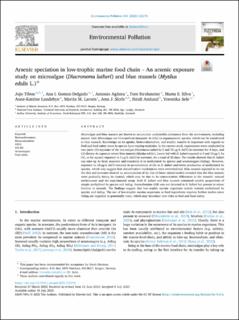| dc.contributor.author | Tibon, Jojo | |
| dc.contributor.author | Gomez Delgado, Ana Isabel | |
| dc.contributor.author | Aguera, Antonio | |
| dc.contributor.author | Strohmeier, Tore | |
| dc.contributor.author | Silva, Marta Sofia | |
| dc.contributor.author | Lundebye, Anne-Katrine | |
| dc.contributor.author | Larsen, Martin M. | |
| dc.contributor.author | Sloth, Jens Jørgen | |
| dc.contributor.author | Amlund, Heidi | |
| dc.contributor.author | Sele, Veronika | |
| dc.date.accessioned | 2023-10-05T11:17:12Z | |
| dc.date.available | 2023-10-05T11:17:12Z | |
| dc.date.created | 2023-09-14T12:15:08Z | |
| dc.date.issued | 2023 | |
| dc.identifier.citation | Environmental Pollution (1987). 2023, 334 . | en_US |
| dc.identifier.issn | 0269-7491 | |
| dc.identifier.uri | https://hdl.handle.net/11250/3094467 | |
| dc.description.abstract | Microalgae and blue mussels are known to accumulate undesirable substances from the environment, including arsenic (As). Microalgae can biotransform inorganic As (iAs) to organoarsenic species, which can be transferred to blue mussels. Knowledge on As uptake, biotransformation, and trophic transfer is important with regards to feed and food safety since As species have varying toxicities. In the current work, experiments were conducted in two parts: (1) exposure of the microalgae Diacronema lutheri to 5 and 10 μg/L As(V) in seawater for 4 days, and (2) dietary As exposure where blue mussels (Mytilus edulis L.) were fed with D. lutheri exposed to 5 and 10 μg/L As(V), or by aquatic exposure to 5 μg/L As(V) in seawater, for a total of 25 days. The results showed that D. lutheri can take up As from seawater and transform it to methylated As species and arsenosugars (AsSug). However, exposure to 10 μg/L As(V) resulted in accumulation of iAs in D. lutheri and lower production of methylated As species, which may suggest that detoxification mechanisms were overwhelmed. Blue mussels exposed to As via the diet and seawater showed no accumulation of As. Use of linear mixed models revealed that the blue mussels were gradually losing As instead, which may be due to As concentration differences in the mussels’ natural environment and the experimental setup. Both D. lutheri and blue mussels contained notable proportions of simple methylated As species and AsSug. Arsenobetaine (AB) was not detected in D. lutheri but present in minor fraction in mussels. The findings suggest that low-trophic marine organisms mainly contain methylated As species and AsSug. The use of low-trophic marine organisms as feed ingredients requires further studies since AsSug are regarded as potentially toxic, which may introduce new risks to feed and food safety. | en_US |
| dc.language.iso | eng | en_US |
| dc.title | Arsenic speciation in low-trophic marine food chain – An arsenic exposure study on microalgae (Diacronema lutheri) and blue mussels (Mytilus edulis L.) | en_US |
| dc.title.alternative | Arsenic speciation in low-trophic marine food chain – An arsenic exposure study on microalgae (Diacronema lutheri) and blue mussels (Mytilus edulis L.) | en_US |
| dc.type | Peer reviewed | en_US |
| dc.type | Journal article | en_US |
| dc.description.version | publishedVersion | en_US |
| dc.source.pagenumber | 12 | en_US |
| dc.source.volume | 334 | en_US |
| dc.source.journal | Environmental Pollution (1987) | en_US |
| dc.identifier.doi | 10.1016/j.envpol.2023.122176 | |
| dc.identifier.cristin | 2175071 | |
| dc.relation.project | Nærings- og fiskeridepartementet: 15333 | en_US |
| cristin.ispublished | true | |
| cristin.fulltext | original | |
| cristin.qualitycode | 1 | |
